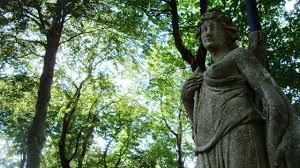Artemis’ Personality, Character Traits, Strengths and Weaknesses
Artemis’ Personality and the Paradox of the Virgin Goddess of Mothers

Artemis is a goddess who knows what she wants and is not afraid to go after it. Her wild, passionate personality serves her well throughout her Iliad and other Greek myths and legends. She is reclusive but also fiercely defensive of the maidens, pregnant women, and young.
She is a champion of both nature and virginity. Fierce, defensive, with a fiery temper, Artemis is the goddess of virgins, maidens, and mothers as well as of the hunt and animals. She is willing to tolerate very little disrespect and does not hesitate to destroy any who dare cause harm to those she protects.
Artemis Powers
Artemis, as a goddess, was immortal and had a great deal of power over mortals and events on earth. In addition to the powers ordinary to all gods and goddesses, she possesses perfect aim with a bow, the ability to change herself and others into animals, and control disease and healing. One mortal who angered her was changed into a deer, chased down and torn to shreds by his own pack of hunting dogs.
When king Oneus of Calydonia neglected Artemis in his annual sacrifice to the gods, she was enraged. She sent a mythical boar to ravage the countryside, driving the people to take refuge within the city walls. It took a group of legendary hunters, including Laertes, the father of Odysseus, to destroy the boar and set the region free.
Participating in the Calydonian Boar Hunt became a feat worthy of legend and myth in itself.
Artemis’ characteristics also included:
- A fierce defensiveness of maidens and young
- Eternal youth
- Virginity
- Defensiveness of purity
- Dislike of marriage and its accompanying loss of freedom
- Choleric temper
- Lack of mercy or sympathy, especially for men
With these abilities and traits, what are Artemis’ powers most directed toward?
In nearly all of her stories, she runs wild through the woods with her nymph attendants, hunting. When she is not busy hunting, she is defending the mother, the maiden, and the young.
Artemis’ Weaknesses
With so many strengths in the list of Artemis’ personality traits, it can be hard to pick out her weaknesses. She does, however, have a few. Her primary weaknesses are her lack of mercy and her pride. There are several versions of the death of her friend, Orion, but all seem to lead back to Artemis being his killer, either directly or indirectly.
In the first story, Orion attacked and tried to rape either Artemis or one of her followers. She took her revenge, killing him. In another story, he happened upon her while bathing in the woods and did not turn away quickly enough to satisfy her pride. Again, she kills him for his indiscretion.
In the final version, her brother Apollo became jealous of her close friendship with Orion. He challenges Artemis, questioning her ability with a bow. Apollo challenges his sister to hit an impossibly-distant target far out to sea. As one of Artemis’ traits is perfect, she hits the target with a bow. She does not discover until afterward that Apollo has tricked her. The target was, in fact, Orion’s head.
Vigor was another of Artemis’ character traits. She was the firstborn of her mother Leto’s twins, preceding her brother by several days. When Apollo emerged, she assisted her mother with his delivery, becoming the champion of pregnant mothers. Her mother’s protectiveness led her to commit crimes against another mother, revealing her weakness of a lack of mercy. Artemis’ strengths and weaknesses often coexist, creating paradoxical stories of her doings.

When the goddess Niobe mocks Artemis’s own titan goddess mother, Leto, for having only two children while she is born 14, Artemis slays seven of her daughters. At the same time, Apollo murders the seven sons, leaving Niobe to mourn her lost children eternally. Even after Niobe is turned to stone, she continues to weep for her lost offspring.
Artemis’ Physical Characteristics
Artemis is always presented as a young woman in her prime, fit and fleet of foot. She wears a knee-length tunic, leaving her legs free for running through the woods. She is fit and trim, spending most of her time hunting and roaming the worlds’ woods and wilds. She is reportedly beautiful, though little detail is given as to the exact appearance she takes on.
There are many depictions. A few show her with multiple breasts, ready to feed a litter rather than a single or twin offspring. Artemis remains a virgin goddess, however, so she will never bear children of her own. Artemis’ special powers, her appearance and apparel are partially the results of the six wishes she begged of her father, Zeus, when she was only a child.
She asked, and was granted, six things of Zeus:
- The mountainous areas as her domain
- Never to marry
- A bow and arrows created by the Cyclopes and a hunting tunic to wear
- To have more names than Apollo
- Sixty nymphs as attendants for her hounds
- To bring light to the world
Artemis and the Giants
Beauty and virginity are included in the characteristics of Artemis, but she was also clever as well. There were reportedly a pair of brothers known as the Aloadae giants. The pair had grown so large and powerful that even the gods had begun to fear them. Artemis knew that the only ones who could kill the giants were the giants themselves. No god or man was strong enough to take them on.
She went to the wood where the two giants were hunting together. Changing herself into a stag, she ran directly between them, tempting them into throwing their spears. At the last possible moment, she dodged the spears, escaping. The thrown spears struck the giants, killing them both.
Additional Artemis Facts and Characteristics
One of the famed Seven Wonders of the World is a temple to Artemis in Ephesus. It is located on the western coast of Asia Minor, known today as Turkey. Fashioned in the 6th century BC, it was larger than even the Parthenon. In the 4th century BC, it was destroyed by fire and later rebuilt. It was destroyed by a Gothic invasion in 267 AD and rebuilt again, but its final destruction took place in 401AD. Today, only the foundation and a single column remain as a reminder of its former glory.
At Brauron in Attica, another site was used to perform sacred rites for young girls and women about to marry. The site served as a temple to the goddess where those interested in her mythology would come to celebrate and study. Although Artemis favored girls and women, young boys are depicted as coming to the site and offering sacrifices to the goddess. There are few remaining artifacts of the pre-marital rites that might have been performed there. Still, some pottery has been recovered, showing young girls running and dancing in wild celebrations before matrimony.
As the goddess of both fertility and virginity, Artemis is the defender and champion of young girls and women. She was, arguably, the first feminist icon, defending the wild freedom of women and their ability to bear children. She hated the institution of marriage and the loss of freedom for the women that accompanied it. She was reclusive, preferring the mountains and forests to Cities, and surrounded herself with nymphs and dryads who were bound by a vow of chastity.
It may seem ironic that she is both the goddess of virginity and childbirth, but Artemis is a champion and defender of women in all their womanhood stages. She is a symbol of youth, vigor and fertility. Artemis represents the embracing of life in all its forms and the fierce defense and passion for life. She may be the goddess that inspired the idea of “Mother Nature,” both nurturing and protective and violently defensive.
Artemis’ defensiveness of girls and women may be linked back to her own origins. After her titan goddess mother, Leto, was impregnated by Zeus, his jealous wife, Hera cursed her. Pregnant with twins, Leto was unable to give birth to her babies anywhere on earth. She was forced to flee to a floating island, Delos, where she gave birth to the twins. Women in Greece paid tribute to Artemis in hopes of gaining a safe, easy, and quick childbirth.
In her hands, carrying the ability to give life, the ability to inflict change (by transforming into animals) and control over disease makes Artemis a powerful goddess, perhaps among the most powerful. In Roman culture, she was given Dianna, the goddess of the moon, while her brother Apollo is known as the god of the sun.
Artemis brings diseases such as rabies, leprosy, and even gout to punish those who displease or dishonor their followers. Yet, she is revered as the goddess of fertility life. Such is the paradox of Artemis’ existence and her place in Greek literature.



Thank you for the info it was very helpful.
If she was a fierce defender of animals was she hunting plants or men in the woods rather than killing animals
I would like to read more about this Goddess
I would like fuller detail on her powers like
i found with Nemesis, because in her case it was like this;
Forces: Tychokenises: Full authority over luck.
Umbrakenises: Has full control over shadows.
Etcetera.
Helped me a lot on my project!
I fully agree, it’s too vague. Sad, because otherwise it’d be perfect. How did you actually find out about the ‘Umbrakenises’ and the ‘Tychokenises’, @Someone?? I searched, like, EVERYWHERE. Nemesis is such an interesting goddess, but Artemis is my fav. Please continue the good work, Clark Roomland!!
PS; I did not mean to offend you, if i did. Just, you know, so you know.
thank you
Really great information about Artemis! Thank you!
Im doing a project on Artemis & this website helps a lot thanks!
Appreciate your knowledge thankyou